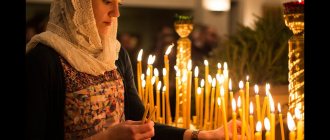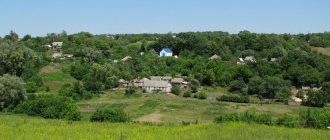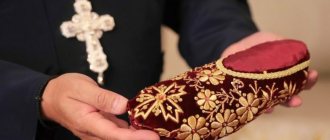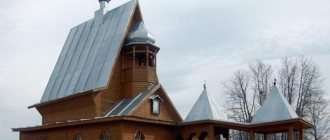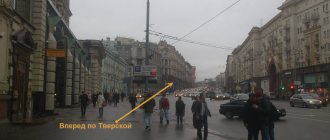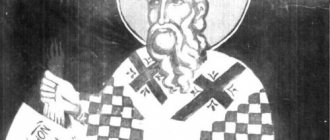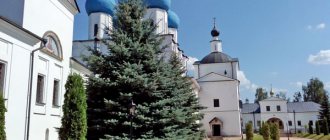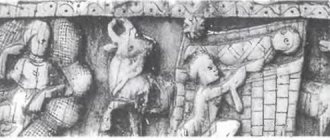For the entire believing population, regardless of material and financial status, of any gender and age, the miraculous icon of Spyridon of Trimifunts, the great righteous man and intercessor of the people, is popular. Saints help all people who believe in them, everyone without exception. For saints, all people are equal.
Memorial Day: December 25
Childhood and youth of the righteous
The future ascetic was born into a simple peasant family. The boy's parents were humble and pious believers: many historians of Christianity draw analogies between the family of Spyridon of Trimythous and the righteous shepherds of the Old Testament. The parents of the righteous man were equally humble, meek and merciful, trying to imitate David, Jacob and Abraham.
From childhood, Spiridon helped his parents in their difficult work: the boy worked in the field, helped his father herd sheep, and did any feasible work.
Interesting to know! In memory of the ascetic’s childhood and youth, he is often depicted on icons against the backdrop of endless fields.
The young man lived in his father's house until he met his future wife. Having been legally married to his beloved, Spiridon became the head of the family, the life of the spouses was quiet and filled with love and mutual understanding. Soon the daughter of the righteous man, Irina, was born in the marriage. However, cloudless family happiness did not last long: soon the wife of the righteous man died. Being a true Christian, the ascetic did not grumble against God, did not accuse Him of injustice. Having mourned the death of his beloved wife, the Saint decided not to tie the knot with any other woman and devote his life to serving the Lord.
Life of the saint
In the Byzantine tradition, the hagiographer of the saint was Simeon Metaphrastus, the compiler of a whole corpus of lives of Byzantine saints; in Russian - St. Dimitry Rostovsky.
Useful materials
According to the life of the saint, he was born into a simple family on the island of Cyprus at the end of the third century. His family was not rich; Spiridon helped his parents from childhood by tending sheep. His type of righteousness was close to that of the Old Testament; he tried to be like the simple-minded shepherds of the Old Testament, “imitating David in meekness, Jacob in simplicity of heart, and Abraham in love for strangers.”
St. Spyridon of Trimifuntsky School or art. center: St. Petersburg Beginning of the 19th century. Canvas, oil, wood. 166 × 71.8 cm State Museum of the History of Religion, St. Petersburg, Russia See in the “Gallery”: Spyridon of Trimifuntsky, bishop († c. 348)
Little is known about the early years of the saint. He married a kind, pious woman, who soon died, leaving him a daughter, Irina.
After the death of his wife, during the reign of Emperor Constantine the Great (306 - 337), he was consecrated (ordained) bishop of the city of Trimifunt (Tremetusia), on the island of Crete. While in the rank of bishop, he remained an ascetic, living very modestly, combining devotion to the Lord and merciful deeds. The first miracle described in the Russian hagiography of the saint, performed through the prayer of St. Spyridon of Trimifuntsky, was also akin to the Old Testament.
In the city where the saint lived there was a terrible drought, St. Spyridon took pity on the poor peasants, whose lives directly depended on the harvest, and prayed to the Lord for them. Through the saint’s prayer, the rain fell with such force that it saturated the earth for a long time. A rich harvest saved people from hunger. The miracle was remembered by the people. St. Demetrius of Rostov compares the prayer of the Saint with the prayer of the Prophet Elijah, who also had the power to cause rain, “locking or opening the heavens.”
St. Spyridon of Trimifunt was also endowed with a special gift of providence of souls; human thoughts were revealed to him. A certain woman, who was in fornication, wanted to wash the saint’s feet, thus repeating the acts of St. Mary Magdalene, who washed the Savior’s feet. But there was no repentance in her heart. St. Spyridon meekly told the woman what was going on in her soul and exposed the passion for fornication. Since then, she has completely changed and brought repentance.
The ascetic activity of Saint Spyridon of Trimythous is well known. The time of his episcopal service coincided with the flourishing of Christian communities; Emperor Constantine made Christianity the official religion of Constantinople and all of Byzantium. In the fight against the anti-Trinitarian heresy of Arius, the formation of dogmatics took place. Arius was an influential bishop; he taught his flock that Christ does not have the same nature with God the Father, but was created by Him.
The Russian hagiographer writes about the participation of St. Spyridon at the First Ecumenical Council, in the city of Nicaea, and about the dispute that the “unlearned” saint, led by divine grace, won over the philosophizing heretics.
Wanting to clearly demonstrate the doctrine of the Holy Trinity, St. Spyridon of Trimifuntsky took out a burnt brick, showed it to those present, and then squeezed it in his hand, flames shot up from the brick and water spilled. The saint still had clay in his hand. “Behold, there are three elements, but the plinth (brick) is one,” said St. Spyridon then, “so in the Most Holy Trinity there are Three Persons, but the Divinity is One.”
He joined the Council Fathers, who professed the dogma of the uncreatedness of Christ, the Son of God.
There are known cases when St. Spyridon of Trimifuntsky raised the dead. He brought back to life his daughter Irina and the dead child of a pagan woman, who later converted to Christianity.
St. Demetrius of Rostov writes:
“St. Spyridon, being himself virtuous, directed others to virtue, and those who followed his admonitions and instructions were benefited, and those who rejected them suffered a bad end.”
The saint not only helped people, but exposed the evil in them, punishing them for sins, he gradually led a person through the three degrees of human service to the Lord. The first is the worship of a slave who serves the Lord out of fear, the second is the service of a hireling for a reward; the third is the ministry of the son, who serves God out of love.
The spiritual path of Spiridon Trimifuntsky
Having decided to serve the Lord, the ascetic becomes a priest. Soon he was appointed bishop in one of the Cretan cities - Trimifunt. It is there that the Saint continues to do works of mercy.
Having occupied a fairly high church position, the Saint did not abandon his previous way of life; his life remained just as modest and ascetic. The righteous man was ready to share with every person everything he had. The fame of his benevolence and mercy spread far beyond the borders of one city: every traveler could find shelter in the priest’s house, and the Saint was ready to share his modest meal with every beggar.
For his immeasurable kindness and selflessness, the righteous man was awarded the gift of miracles and clairvoyance: the Lord gave Saint Spyridon the ability to see the future, heal seriously ill people, and cast out demons.
Miracles according to prayers to Spyridon of Trimifuntsky
In 2007, the relics of the wonderworker Spyridon were brought to the Danilov Monastery (Moscow) from the island of Corfu (Greece). A very large number of believers came to worship the shrine. They had to stand in line for several hours. Many received help through prayers to the holy wonderworker. For example, the family of Boris and Elena with three children, who lived in a communal apartment and did not have the means to improve their living conditions. Soon after venerating the holy relics, they received a municipal apartment out of turn.
In 2014, through the prayers of his daughter and granddaughter to Saint Spyridon, Peter, a resident of St. Petersburg, received healing. A repeat MRI did not confirm the early diagnosis of an 8 cm hematoma.
Participation of the Saint in the First Ecumenical Council
According to historical information telling about the events of 325, Spyridon of Trimifuntsky, together with other priests, participated in the First Ecumenical Council. The most famous was the dispute between the Saint and one of the Greek philosophers who defended the “Aryan heresy.”
Arianism, or the Aryan heresy, is one of the early Christian movements, the concept of which was proposed by the Alexandrian priest Arius. The essence of the new religious movement was the assertion of the non-consubstantiality of God the Father and God the Son. After the First Ecumenical Council, this statement was recognized as erroneous.
In his dialogue with the apologist of Arianism, Saint Spyridon achieved great success: the man who had previously defended heretical dogma renounced his erroneous judgments and became a zealous defender of Christianity.
Another historical event that took place at the Council of Nicea became no less famous: the Saint found unusual arguments in favor of the truth of the concept of the Holy Trinity. Spiridon took the brick in his hands and squeezed it tightly. At that same second, fire shot up, water flowed onto the ground, and only clay remained in the hands of the righteous man. The saint said that just as the three elements are contained in one brick, the Three Persons are combined in the One Deity.
Life of the Wonderworker
The Wonderworker was born in Cyprus into a simple working-class family. He was a kind and humble child, tending sheep. He did not receive a high education, but from an early age he tried to live piously, taking the example of virtues from the Old Testament forefathers. The young man loved to host travelers, was gentle with people, and helped the poor. He transferred all the virtues to his family life, marrying a meek and chaste virgin.
Read about the saint:
- Hand of Saint Spyridon
- Relics of Saint Spyridon of Trimifuntsky
- Saint's Day
Unfortunately, Spiridon became a widower early. He gave all his property and finances to the poor. The Lord Himself helped the man in good deeds; with His holy help, the future saint learned to heal ailments, cast out demons, and help people in all their needs.
The consequence of Spyridon's godly life was his appointment to the post of Bishop Trimifunt. But being in a high position, the saint, as before, showed mercy and practiced virtue.
In 325, Spyridon participated in the 1st Ecumenical Council, where he denounced the philosopher who called for the acceptance of the heretical teaching of Arius. He showed the audience proof of the unity in the Holy Trinity: taking a brick in his hands, he squeezed it with force. As a result, a fiery flame came out of the brick, then a thick stream of water flowed out of it, and the clay remained in the hands of the saint. Thus it happened that there is one brick, and three elements - the same is true in the Trinity: It has three Persons, but the Divinity is One. His subsequent speech about Christ and doctrinal dogmas yielded blissful results: the previously furious Aryan heretic instantly became a defender of Orthodoxy and accepted Baptism.
Wonderworker Spiridon of Trimifutinsky
Miracles of Saint Spyridon
One day, Cyprus suffered a severe drought: people were dying of thirst and hunger, previously rich harvests withered on the vine. The saint offered prayers to the Almighty and the long-awaited downpour sanctified the Cypriot land, which soon yielded a rich harvest, the famine and human pestilence stopped.
Spiridon always helped poor people in their needs. One day, a poor man asked a wealthy townsman for a loan of grains for sowing and promised to repay the debt after harvesting. But the rich man demanded gold from the poor man as collateral. The upset peasant came with his grief to the miracle worker and he promised to help him by sending the poor man home. Taking the snake in his hands, the miracle worker turned it into gold and gave it to the plowman, so that he would give it as collateral and return it after the harvest. Having received the grain, the farmer sowed the field and received a rich harvest. Having bought the gold from the rich man, he returned the ingot to the saint, who, in front of the peasant’s eyes, again transformed the gold into a snake. The peasant was very surprised by the miracle performed and thanked God.
Spiridon Trimifuntsky
One day a pagan townswoman came to Spyridon. Weeping bitterly, she laid the dead body of the baby at the feet of the saint. Having prayed to the Almighty, the saint infused life into the baby. The amazed mother, seeing her child alive, immediately died of joy. But the saint ordered her to resurrect and stand on her feet. The woman seemed to awaken from a deep sleep, stood up and took her beloved child in her arms.
The end of life's journey
The height of the rank was not a reason for the pride of the saint. He worked in the fields along with the poor. During the harvest, a miracle happened and Spiridon’s head was covered with cool dew, and his hair changed color. The saint realized that the Heavenly Father was calling him to Himself, that the time had come to leave earthly life for heavenly life. Around 348, he gave up his soul to the Lord.
Spyridon of Trimifunt was buried with honor in the city of Trimifunt, and at his tomb, for the Glory of the Lord, numerous miracles and healings were performed and continue to be performed to this day.
The miraculous help of the Saint
In the bishop, the parishioners found a kind and loving mentor to whom they could turn for help in any matter. Often people suffering from illnesses came to the righteous man, and through the prayers of the Saint they received healing.
Once upon a time, a season of prolonged drought began in Cyprus, which threatened to cause crop failure. Saint Spyridon knew how difficult it would be for the people on the island if the blessed rain did not fall on the soil: many of them could simply die of hunger. The righteous man fervently prayed to the Lord, asking for help and protection for his people. The next day, the entire sky over Cyprus was overcast, and a long rainy season began. Moisture generously watered the earth. Local residents subsequently said that there had not been such a rich harvest in the fields, gardens and vineyards for a very long time.
At first, people rejoiced that they managed to avoid starvation, but soon they stopped appreciating God’s mercy and abundance of food and began to sin as before. Then times of drought and famine came again on the island. The bins of the poor became empty every day, and rich people learned to profit from the misfortune of others by selling food at the highest price.
One landowner had a very large supply of grain, flour and other products. Every day he sold his products more and more expensive. One day a poor man came to his house and asked the landowner for at least one piece of bread so as not to die of hunger. However, the rich man kicked out the poor man, forbidding him from coming to him without money in the future. In tears, a beggar man came to Saint Spyridon, but he calmed him down and shared his modest food with him. The righteous man advised the man to go home and not worry about anything, and he spent the whole night in prayerful appeals to the Lord. The next morning a severe thunderstorm began over the island. A rainstorm washed away the ground near the granary of a greedy landowner, one of the walls of the building was destroyed, and all his supplies were washed away by water. Poor people collected food, which the flow of water carried through the streets. The poor man, who just yesterday had been completely exhausted from hunger, also collected some food for himself. The rich landowner realized that the events that took place were the result of his greed. He came to the poor man's house and said that he could come to the granary any day and take as much bread as he wanted. So the Lord taught a lesson to the landowner and saved the life of a man who was on the verge of starvation.
One man was falsely convicted, spent a long time in prison and was sentenced to death for a crime he did not commit. Having learned about this, Spyridon of Trimifuntsky immediately hurried to the aid of the unfortunate man. However, the Saint’s path was blocked by a stream, which overflowed heavily after the previous downpour. The righteous man ordered the stream to stop and crossed on dry land to the other side of the street. All the people who witnessed this event rushed to the city judge and told about what they saw. The judge was convinced that the person interceding for the condemned man was sent by God, so he immediately released the prisoner.
How and what to pray to the Saint, what to ask for
Even the Righteous One willingly extended a helping hand in resolving financial, property or everyday difficult situations, as a result of which the Orthodox found themselves on the verge of poverty and starvation. There is a legend that Spyridon travels around the world and gives gifts to the poor and every year he is given new shoes, but still before the new year they come out completely trampled. One of the most famous among Orthodox people is the prayer to this elder about the sale of a home; they say that Spiridon helps to successfully conclude an agreement and quickly find a way out of a difficult housing situation.
A sincere prayer to St. Spyridon can help in finding the right solutions in the following everyday situations: • Selling your apartment profitably. • Donate money for good intentions (for example, patronage or healing). • Repayment of monetary debt. • About the house or apartment. • About the successful development of your business. • On the sale of real estate to support your business. • About success in resolving business problems. • About housing (purchase, exchange or exchange).
The holy elder helps with the sale of housing only in those situations when a believer has good thoughts and is in distress.
This saint is considered the only Christian God's Pleasant, whose patronage extends to financial values and to finding the right answer to housing or property difficulties.
Icon of Spyridon of Trimifuntsky
And today, many believers need the help and intercession of the famous Saint. Christians turn to the righteous man with prayers for help, standing in front of his icon in the temple or at the home iconostasis.
On the icon the Saint is depicted as an elderly gray-haired man dressed in the vestments of a clergyman. In almost all versions of the icons, the Saint holds the Holy Scripture in his left hand. The right hand of the Saint in many icons is raised in blessing. However, there are also versions of the image in which the righteous man holds in his hands the very brick that became proof of the concept of the Holy Trinity at the First Ecumenical Council. An obligatory attribute of attire in all images remains the omophorion - an integral part of the bishop’s clothing.
In the icon painting tradition, there are different versions of the icons of Spyridon of Trimifuntsky; these can be either half-length images of the Saint or full-length images. In some images the Saint is depicted sitting on a throne.
The head of the righteous man on many icons is covered with a headdress unusual for a priest - a cap made of sheep's wool. This traditional shepherd's headdress reminds believers of the early years of the Saint's life in his home village.
One of the most famous icons of St. Spyridon is the one on which he is depicted together with St. Nicholas the Wonderworker.
The Life and Miracles of Saint Spyridon of Trimythous
The life of the saint surprises with its miracles. If you believe the legends, he tamed the elements, prevented droughts, healed people and more than once raised the dead. Spiridon was born into a peasant family and, like his parents, was meek and humble, working on fertile land, cultivating grain. That is why on the icon of Spyridon of Trimifuntsky, in addition to his face, grain fields are depicted. Spiridon was married for a short time, but his wife died early, the Lord did not give her a long life. Despite this, Spyridon did not become embittered with the Lord, but continued to profess honesty, generosity and mercy.
There are known facts that Spiridon divided all his few incomes among the poor. For his generosity, the Lord endowed him with the ability to heal people from illnesses. Sometimes one word was enough to heal or resurrect, so strong was its power. Often believers can see the icons of Nicholas the Wonderworker and Spyridon of Trimifuntsky together, since these saints are similar in the abundance of their miracles and mercy towards people.
For such merits, Spiridon was appointed bishop in the city where he lived, Trimifunt. But, even being in such a high position, Spiridon continued to work in the fields, give his income to the poor and work miracles. He died in 348 while praying.
During his life, the miracle worker visited many countries: Egypt, Syria, many European countries. He was merciful to everyone, both pagans and fellow believers. Many, thanks to him, began to believe in the Lord and received Baptism.
When they pray to Spyridon of Trimifuntsky
Believers turn to the righteous man for help on a variety of issues:
- Remembering how worthily the Saint survived the death of his wife, believers turn to him for help in difficult life situations, when they have to resist despondency and temptations;
- since peasant labor was close to the Saint, people often pray to him for successful farming;
- remembering how righteous Spyridon helped the inhabitants of Cyprus survive the drought, they pray to the Saint for a good harvest and favorable weather;
- in addition, Spyridon of Trimythous is widely known as a fighter against heretical doctrines, so Christians ask him for help in strengthening their faith.
Meaning of the image
Orthodox people have long venerated the holy face of the blessed wonderworker. During his earthly life, Spyridon favored the poor, the sick and the needy. And to this day he helps those who pray to him, including healthy, wealthy Christians.
Icon of Spyridon of Trimifuntsky
He was always sincere in prayer and righteous in deeds.
Prayer Requests
Most often, before the holy face of Spyridon of Trimifuntsky, people ask for resolution of problems:
- in case of job loss and layoff;
- on resolving material problems;
- about finding a decent income;
- on timely repayment of debts;
- about purchasing your own home;
- on preventing sudden loss of livestock in peasant villages;
- about preserving the harvest;
- during litigation;
- in healing from illnesses;
- to resolve family problems;
- to prevent cruelty between loved ones;
- for business success;
- when oppressed by enemies;
- for guidance in making important and fateful decisions.
Important!
It is necessary to understand that the saints and their Faces do not “specialize” in fulfilling petitions in any particular areas. Appeal to heavenly intercessors should occur with faith in the Power of the Heavenly Father, and not by the power of a separate icon or prayer. Festive Orthodox Icons of Spyridon of Trimifuntsky on the SLYATTSY website - we will help you select and quickly deliver icons throughout Russia!
Where are the relics of Saint Spyridon
The relics of the righteous man are now on the island of Corfu, in a temple named after the righteous man himself. The holy relics of the righteous man are carefully kept in a shrine decorated with gold and silver jewelry.
Interesting to know! Many inexplicable miracles also happen to the relics of the righteous. Their temperature constantly remains at 36.6 degrees, and the robes with which the Saint’s body is covered become unusable after some time. The temple servants say that it looks as if the righteous man is constantly wandering somewhere. Residents of the island believe that the Saint constantly walks around the island in order to hear their prayers in time and immediately come to their aid.
After the temple servants change the robes covering the Saint’s body, his fabric shoes are divided into small pieces, which are called “filahto”. Every Christian can purchase an icon with a piece of such a shoe.
The ministers of the church in Corfu do not divide some shoes into parts, but send them as gifts to ministers of other Orthodox churches. There are seven such temples on the territory of Russia, the most famous of them is the Church of the Intercession, located on the territory of the Danilovsky Monastery. Anyone can come to the church and venerate the shrine.
Iconography
The numerous benefits of the saint found expression in an extensive icon-painting tradition. Icons of St. Spyridon of Trimifuntsky received very wide circulation both in Byzantium and in Russia. He is one of the most beloved Russian saints, revered on a par with St. Nicholas the Wonderworker.
Saints Blaise and Spyridon School or art. center: Novgorod Ok. 1407 Lazarev 1969: The end of the 14th century. Novgorod icon 1983: XV century. Russian icon 1988: Second half of the 15th century. Lazarev 2000/1: Ok. 1407 117.5 × 85.5 cm State Historical Museum, Moscow, Russia Inv. 99727 AND VIII 5756
The earliest images of Saint Spyridon of Trimythous are found in Greece, in the monasteries of Stavronikita and Dionysiata (on Athos), dating back to the sixteenth century. In Russia, the first surviving icons of the saint are known from the beginning of the fifteenth century, for example, a fresco in the Church of the Transfiguration of the Lord on Ilyin Street in Novgorod. Numerous ancient lists are also in museum collections.
St. Spyridon of Trimifuntsky is represented on them in traditional episcopal vestments, with an omophorion, and on his head is a wicker cap, in which he is always depicted. There is a legend that this basket-like headdress is associated with the name of the saint (in Greek, Spyridon means “strong, reliable”), or with his shepherd past. In fact, a cap made of felted wool has its own meaning - it is a prototype of the modern episcopal miter. In the hands of St. Spiridon Gospel or scroll.
On the icon from the Athonite monastery of Dionysiates, the saint is depicted with a brick from which fire and water are bursting out - a very common iconographic depiction that refers us to the central episode of the life of St. Spyridon of Trimifuntsky.
Miracle of Flora and Laurel. Saints Blasius and Spyridon School or art. center: Obonezhye First half of the 16th century. 67.7 × 51 × 2.4 cm State Russian Museum, St. Petersburg, Russia Inv. 30425
In Rus', at the beginning of the fifteenth century, its own iconography of the saint appeared. It can be classified as a hagiographic icon. It is unusual in that the plot combines two saints at once: St. Blaise, who is considered the patron saint of the peasantry and St. Spyridon of Trimifuntsky, that spiritual shepherding was often revealed to ordinary farmers.
The icon very clearly shows the principle of compiling a hagiographic iconographic plot, created to meet the simplest human needs. Two saints pray to the Lord for the well-being of the dumb creature and its owners. A similar plot is repeated in the icon of the Cathedral of the Archangel Michael with the upcoming St. Blaise and St. Spyridon of Trimifuntsky.
Interesting fact
Saint Spyridon is often depicted together with Nicholas of Myra the Wonderworker, as if doubling their prayer power.
The waist-length icon of the saint is widespread; it is complemented by stamps with hagiographic episodes. In modern icon painting, the shoulder-shaped image of Saint Spyridon of Trimifunt is also painted. On the island of Corfu, in northern Greece, in the temple of St. Spyridon of Trimifuntsky contains the incorruptible relics of the saint; they miraculously preserve the temperature of the human body, 36.6, and the weight of an adult. There, at the temple, you can venerate the miraculous icon of the saint.
Royal Doors Filaret School or art. center: Cyprus 1758 Wood, gesso, tempera; thread. 160 × 40 cm State Historical Museum, Moscow, Russia
How to pray to Spyridon of Trimifuntsky
- In order to pray to the Saint, it is not necessary to go to the island of Corfu; you can do this in the nearest Orthodox church or at home.
- If there is no icon in the temple depicting Saint Spyridon, you can pray to him at the icon of All Saints: such a prayer will definitely be heard.
- Before you begin to pray to the saints of God, you should turn to the Lord, ask for His mercy and repent of your sins.
- It is important to remember that prayer is our way of communicating with the Lord, the Mother of God and the Saints, so we must not only forgive about something, but also remember to thank Them for their help.
When turning to the Saint, you can read the following prayer:
Oh, great and wonderful saint of Christ and wonderworker Spyridon, Kerkyra praise, the whole universe, bright lamp, warm to God, prayer book and to all who come running to you and pray with faith Hey, quick intercessor! You gloriously explained the Orthodox faith at the Council of Nicaea among the Fathers, you showed the trinity of the Holy Trinity with miraculous power and you completely put the heretics to shame. Hear us sinners, the saint of Christ, praying to you, and by your strong intercession with the Lord, deliver us from every evil situation: from famine, flood, fire and deadly plagues. In your time of life you delivered your people from all these disasters: you saved your country from the invasion of the Hagarians and from famine, you saved the king from an incurable illness and saved many You brought sinners to repentance, you gloriously raised the dead, and for the holiness of your life there were angels , invisibly in the church singing and serving with you, you had. Therefore, Lord Christ, glorify you, your faithful servant, for all the secret human deeds have been granted to you to understand and to expose those who live unrighteously. You diligently helped many who lived in poverty and lack, you nourished the poor people abundantly during the famine, and you also fed many signs with the power of the living Spirit of God in you. You created life. Do not forsake us either, Saint of Christ, remember us, your children, at the Throne of the Almighty and beg the Lord to grant forgiveness to our many sins, a comfortable and peaceful life. m, the death of the belly is not shameful and peaceful, and eternal bliss in the future He vouchsafes us, so that we may send glory and thanksgiving to the Father and the Son and the Holy Spirit, now and ever and unto the ages of ages. Amen.
Miraculous icons
In Russia there are many praying and miraculous icons of the saint; they are found in almost every city. The most famous, revered for many years, icon of the saint with a particle of his relics, decorated with a rich robe, is found in Moscow, in the Church of the Resurrection of the Word, on Bryusov Lane, which runs from Bolshaya Nikitskaya to Tverskaya Street. The Church of the Intercession of the Danilov Monastery has an icon and a shoe with a particle of the relics of the saint. The saint's shoes with his miraculous icon are also kept in the Savvino-Storozhevsky Monastery in Zvenigorod near Moscow.
In St. Petersburg, in the temple of the Life Guards of the Volyn Regiment in the city of Oranienbaum (Lomonosov), an icon of the saint painted in Greece is found, through prayer to it many miracles of the saint occur, on the temple website there is a kind of chronicle of letters from grateful pilgrims.
Memorial Day of Spiridon of Trimifuntsky
The Orthodox world honors the memory of the Saint on December 25 - this is the day when the respected righteous man left the earthly world. According to legend, even on his deathbed the ascetic continued to offer prayer to the Lord.
On the day of remembrance of the Saint, solemn services are held in Orthodox churches, during which believers offer songs of praise to the ascetic and remember the miracles that he performed for the sake of the happiness and well-being of ordinary people.
Much more can be said about the life path of the Saint: his life is an example of true Christian kindness and service to the Lord and people. From ancient times to the present day, Orthodox believers treat with special reverence and love the personality of the Saint, who tried to devote every minute of his life to free service to his neighbors. People's memory continues to carry his good deeds and acts of mercy through the centuries, trying to convey to future generations the story of what an amazing person Spyridon of Trimifuntsky was.
